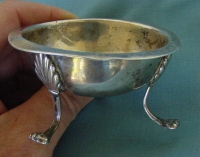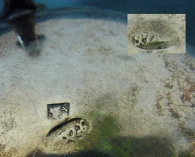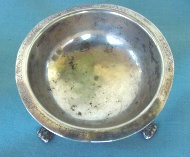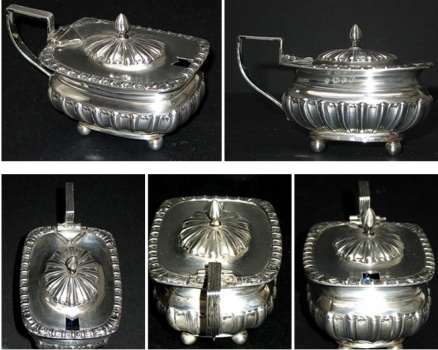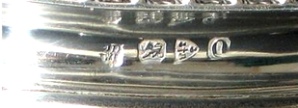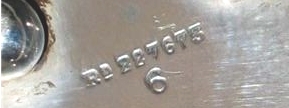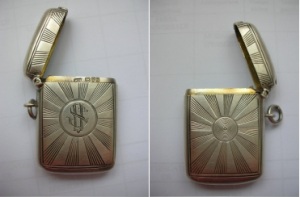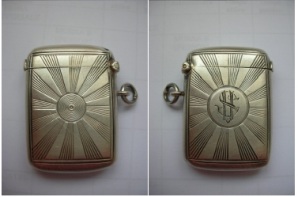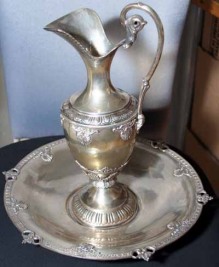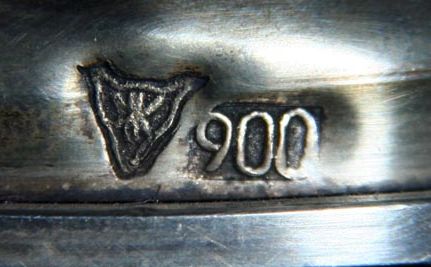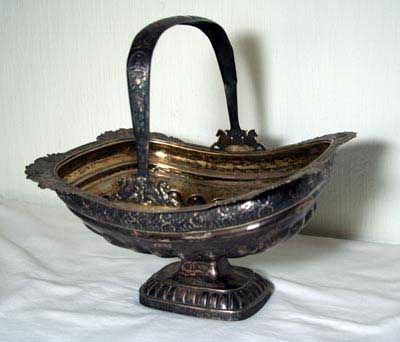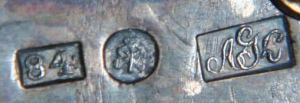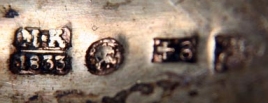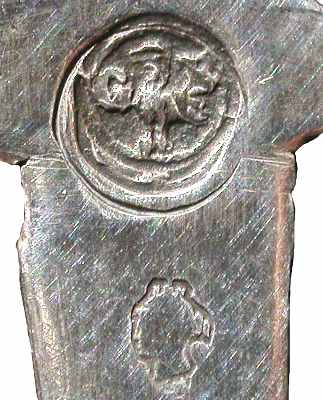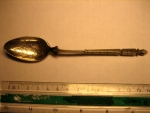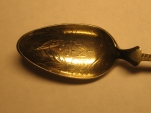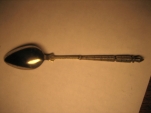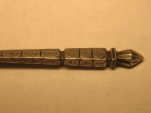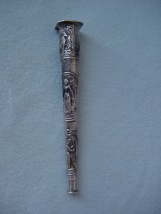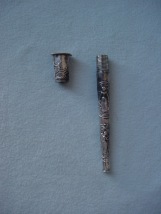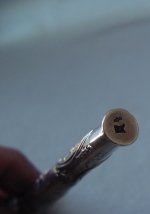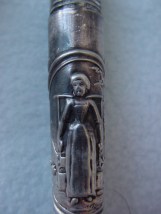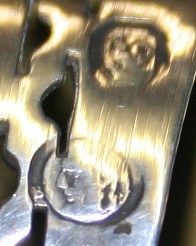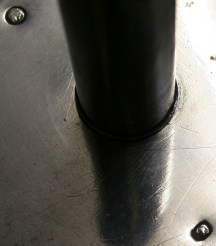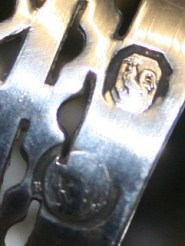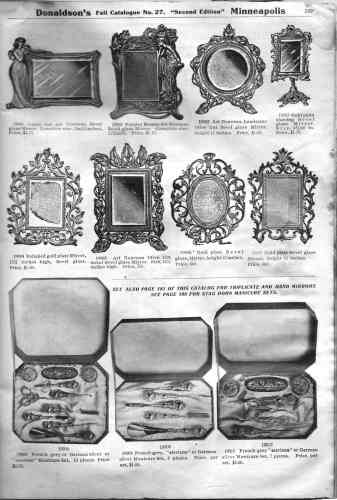 newsletter # 37 - May 2007
newsletter # 37 - May 2007www.ASCASonline.org
email: silverassociation@yahoo.it
YOUR GUIDE TO THE MAY NEWSLETTER:
articles new members
members' window
|
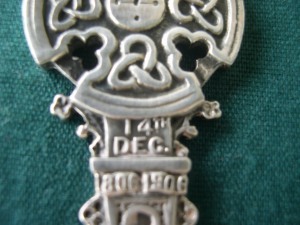 Wayne Bednersh presents:
Wayne Bednersh presents:ONE and ALL A 6" hand made spoon which appeared to be a memento of a 100th celebration led the author to a far reaching excursion into the development of modern medicine including the founding of Johns Hopkins medical school, the poetry of Walt Whitman, the cosmic consciousness of Dr. Bucke and the ancient religious mystical philosophies of the Buddha, Jesus and the Kabbalah as well as Canadian history. The journey was interesting and fascinating and ended up in quite a different place than originally expected ... click here |
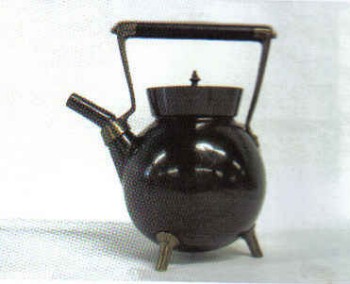 Dorothea Burstyn presents:
Dorothea Burstyn presents:Margo Grant Walsh: Collecting by Design Margo Grant Walsh, retired from a successful career as interior architect first with Skidmore, Owings & Merrill in San Francisco and then with Gensler, now dedicates most of her time to show, lecture about and share her love for metalwork of the Twentieth Century. On April 11th, 2007 the Silver Society of Canada had the pleasure to welcome Margo Grant Walsh to hear her lecture "Collecting by Design". This is the presentation supplied by Dorothea Burstyn, the President of SSC. click here |
New members
Welcome to new ASCAS members:
Jennifer Capps - USA
Edward Cooper - Australia
Rafe Goorwitch - USA
Neil Hewson - Australia
Fabrizio Matta - Italy
Roberto Minazzi - Italy
Feach Moyle - Australia
Andrew Steinberg - USA
Gee Wilson - Australia
Members' Window # 37
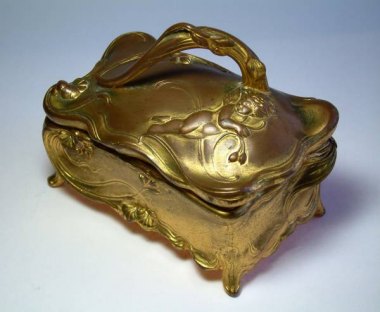
|
Mail to ASCAS: e-mail
silverassociation@yahoo.it
Graham Parry writes:
I recently acquired what I think is an early silver salt.
The diameter is exactly 3 inches or 75mm and total height is 1
7/16 or 37mm.
The shield shaped crest appears to me to have a king or monarch
wearing a crown with the letter N and a line horizontally across
the middle.
The oval crest with initials appear to be P or R and then just
not sure of the rest of initials. Appears to be 3 initials
judging by the length of the oval.
My very limited knowledge suggests maybe early 1700s. I would
love it to be earlier and British but also wonder about Naples
as found an early Naples mark somewhere.
Thanks very much and regards
Graham
your salt is Naples, assayer Gennaro Manara, in use
1835-1863.
I'm unable to identify the maker (but if the initials are PDB it
may be Paolo De Biasio). I have a very similar salt in my
collection. You may look at
http://www.silvercollection.it/pagina203.html in my private
website.
Giorgio Busetto
Robert Massart writes:
I was told that the hallmarks of a silver mustard pot dated
from the year 1764.
Could you eventually confirm this when looking at attached
information?
I also would like to know what the RD number 227675 is referring
to.
Thanks very much for your advice.
Robert Massart
Your mustard pot was made in 1897 and not in 1764.
RD 227675 is, possibly, the number of the patent (REGISTERED)
released in 1894 for this model by the UK Patent Office (see
http://www.ascasonline.org/articolo35.html).
Giorgio Busetto
Marco writes:
These are the photos of an object I received in inheritance.
I believe it's a silver match holder. My question is where, when
it was made and who was the maker.
Thank you for your help
Marco
Your inheritance is a matchbox holder (Vesta case) made in
Chester in 1903.
The maker is William Neale & Sons
Giorgio Busetto
Jacquie Mallory:
...A few months ago I wrote in to ask the membership on their
advice regarding the cleaning of historic silver. I got all
kinds of answers, tried quite a few, but nothing worked well
enough to use each time.
I contacted the Canadian Conservation Institute, and after much
conversing with them and reading massive amounts of literature
from them, we have settled on a method. We now use calcium
carbonate (precipitated chalk) mixed with water. It is a way
less abrasive compared to what we were using before (silvo), has
no odour, and easier to work with.
When you have over 3000 individual pieces of historic silver to
polish, you want to make sure the collection looks great but
maintains its quality. I was worried with all the polishing over
the 10 years that we have had the collection, that we would
eventually do damage to it.
So thanks to the CCI for their help, and thank you to all the
people who sent in what worked best for them!!
Jacquie Mallory
Curator Soo Line Historical Museum
Weyburn, Sask. - Canada
Riccardo Bresemann writes:
... I have some nice pieces, and for one I would like to know
the origin and age. It's a silver ewer or pitcher, probably for
baptism rituals. An ancestor on my wife's side (she's Turkish)
was a trader and this ewer is an heirloom.
A few days ago I saw a very similar one on TV when the Pope did
the traditional foot washing on Holy Thursday. It was in gold,
but looks very similar. I have some books about international
silver hallmarks and I browsed the whole internet - but I
couldn't identify the hallmark on the ewer and the plate.
I send two pictures of the ewer and the hallmark. Maybe anybody
at ASCAS can identify this piece.
Thank you and warm regards
Riccardo Bresemann
Another question by Riccardo Bresemann:
... I have another nice silver item which is an heirloom from
my own family. It was given my grandmother's sister-in-law in the
early forties of last century while she was working as a
cleaning woman at the castle of Count Wilhelm-Friedrich zu Lynar
in eastern Germany.
This item was given her one day as a gift. Now it's in my hand
and of course I tried to identify it and its history. It's
marked at three places. I know the origin of manufacturing (St.
Petersburg), the date (1833) and the assayer (MK = Mikail
Mikailovich Karpinski), but I could not identify the silversmith
(probably "AK"?) and why and how it took its way from St.
Petersburg to Germany. It also has two later engravings: "1897"
on one side and "M" (probably for Maxilimilian zu Lynar, who was
the Count at this time) on opposite.
Here you can find the pictures:
Thank you again for your help!
Riccardo Bresemann
Fredric Sinfield writes:
... Here is a little item that might be of interest.
The shortest is unmarked, 130mm long with a twist part way down
and a finial that appears to be a spoon.
The other is 170mm long has two marks on the reverse, the
crowned head is the Italian mark for 800 silver, in use from
1872 to 1934 and the maker's mark that appears to be a bird with
initial "G" within a circle.
They are similar to the hair pins in
article #64 on ASCAS website " Italian silver hair pin: the
'sperada' " and I'm wondering if the maker might be identified.
Thanks,
Fred.
Robert Massart writes:
I hope that you will be able to help me to gather some
information about this silver spoon.
I know the spoon since my childhood, because my parents used it
as a tea spoon. However, I have no idea at all where it
originally came from. Was it made in Belgium ? I only can see
that the silver content is 800/1000, but I do not know the other
hallmark. Maybe it is the maker's mark.
In any case it is wonderfully worked as you can see on the
detailed pictures.
I will be very grateful for any information I can get from you
or from the members about this beautiful craftsmanship.
Thanks in advance.
Robert Massart
Replies to questions
| Debbie
Cracovia receives this reply about her silver item
( see April Newsletter) Fredric Sinfield writes: ... In reply to Debbie Cracovia: It is an early 19th
century Dutch needle case made after 1814.
|
Maurizio
Perota receives this reply about the letter codes on the
mark of French 'Département'
( see April Newsletter) some information about letter/number codes 1803-1809 of French
Département in Italy is available in Argenti Italiani
dell'Ottocento, vol. 2 (V.Donaver-R.Dabbene):
|
"A PAGE per MONTH"
In this column we present a page (one
page only) obtained from makers' brochures, books, auction
catalogs or whatever other printed paper, which may be of
particular interest for ASCAS members.
The images will be published at a "low resolution" level and for
private and personal use only
"A WORD per MONTH"
In this column we presents an abstract
from a page of the "What is? Silver Dictionary"
courtesy of
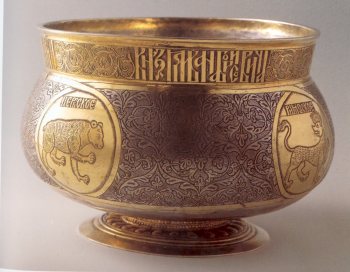
|
BRATINABratina is an early vessel used in Russia. Bratina derives from "bratchina" or "bratovshchina", a feast of brothers. They are large spherical vessels often with inscriptions referring to reunions of relatives.The first written mentions of bratina made in precious metal date to the beginning of the 16th century, but only later examples still survive..... more |
| SILVER SOCIETY
OF AUSTRALIA ASCAS activity and its Newsletter is cited in the " Here & There" column of April 2007 NewsLetter published by The Silver Society of Australia, where Dorothea Burstyn's article about "Apple Corers" is quoted with great interest. Our thanks to The Silver Society of Australia and its President John Szasz for their help in advertising ASCAS activity (you may note many new Australian members in ASCAS list of this month). For all enquires about subscriptions to The Silver Society of Australia you may contact John Heathers (Treasurer) e-mail: john_heathers@bigpond.com
|
Closing our MAY 2007 edition of ASCAS Newsletter I hope you have appreciated its content.
Your comments, suggestions and advice will be of great help.
My thanks to Wayne Bednersh (USA), Riccardo Bresemann (Germany), Dorothea Burstyn (Canada), Jayne Dye (USA), Jacquie Mallory (Canada), Robert Massart (Belgium), Graham Parry (Australia), Fredric Sinfield (Australia), Joanne Wiertella (USA) for their invaluable contributions.
Giorgio Busetto
Secretary
ASCAS is a community of people having a common
interest in antique silver.
|

